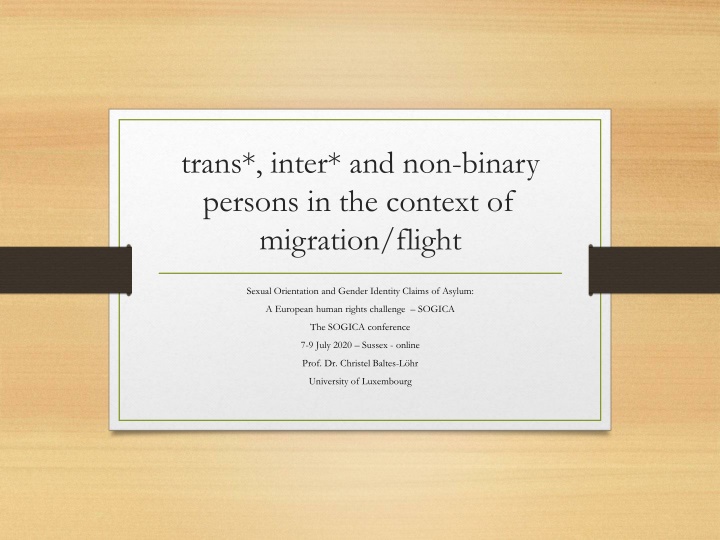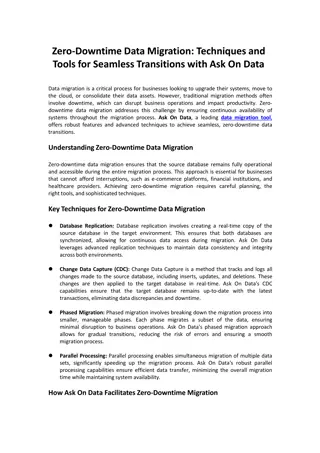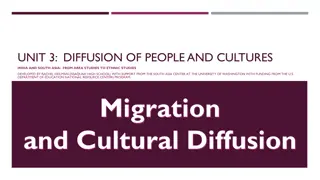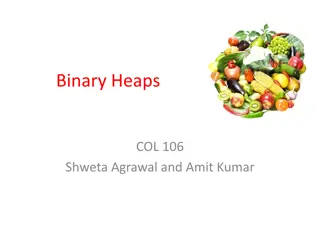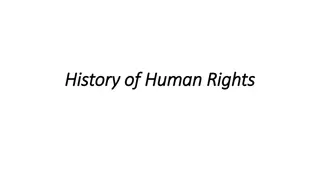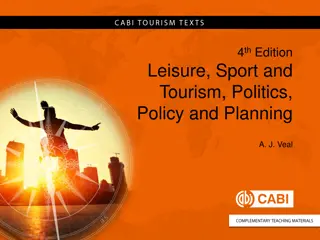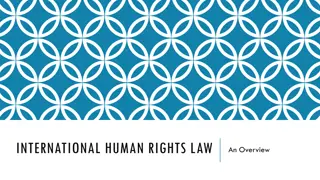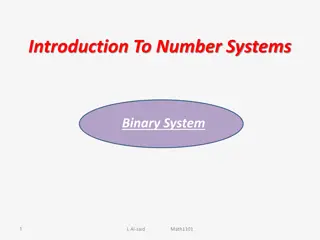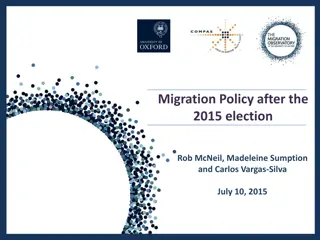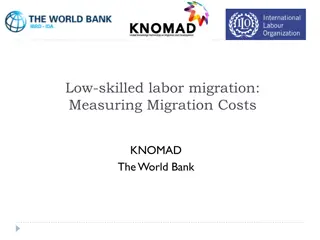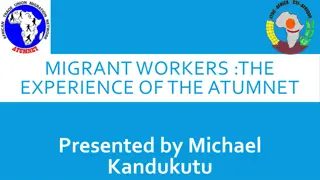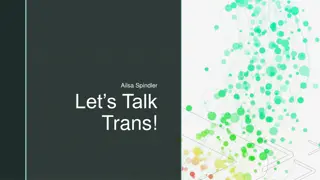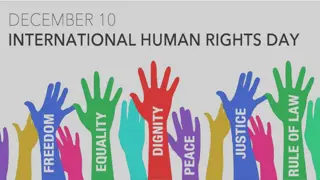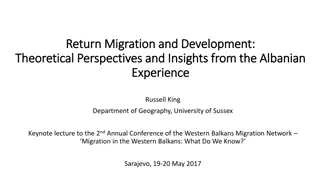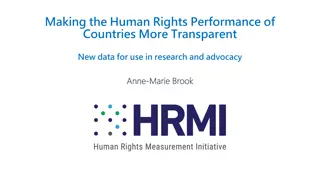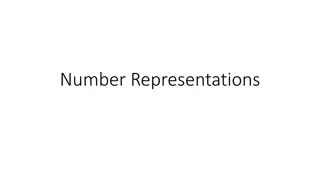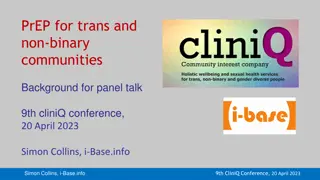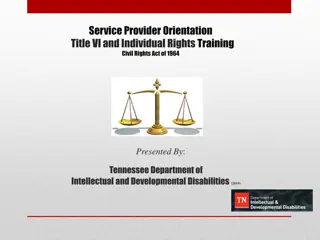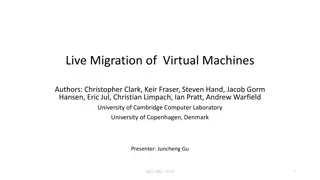Challenges Faced by Trans, Intersex, and Non-Binary Individuals in Migration: A Human Rights Perspective
This presentation discusses the challenges encountered by trans, intersex, and non-binary individuals during migration processes, focusing on gender as a continuum and its implications on migration experiences. The study explores theoretical frameworks, professional perspectives, and real-life experiences to shed light on the unique needs and rights of these individuals in the context of asylum claims. By redefining gender norms and migration paradigms, the research aims to address the complex realities faced by marginalized communities in the European context.
Download Presentation

Please find below an Image/Link to download the presentation.
The content on the website is provided AS IS for your information and personal use only. It may not be sold, licensed, or shared on other websites without obtaining consent from the author.If you encounter any issues during the download, it is possible that the publisher has removed the file from their server.
You are allowed to download the files provided on this website for personal or commercial use, subject to the condition that they are used lawfully. All files are the property of their respective owners.
The content on the website is provided AS IS for your information and personal use only. It may not be sold, licensed, or shared on other websites without obtaining consent from the author.
E N D
Presentation Transcript
trans*, inter* and non-binary persons in the context of migration/flight Sexual Orientation and Gender Identity Claims of Asylum: A European human rights challenge SOGICA The SOGICA conference 7-9 July 2020 Sussex - online Prof. Dr. Christel Baltes-L hr University of Luxembourg
Overview I The presentation will bring light in the situation of trans*, inter*, and non- binary persons (TIN persons) during their migration/flight process. Using the figure of the continuum, gender and migration will be discussed from a more theoretical point of view and used as framework for new findings and needs of inter*, trans* and non-binary persons on migration/flight and professionals working with them, interviewed in Germany and Luxembourg. The presentation will cover the discussion about the theoretical figure of the continuum, developed by Baltes-L hr in 2014. This figure opens the perspective to estimate all genders as equal and eliminates the more or less hidden hierarchization of a consideration of trans*, inter* and non-binary persons as so called 3rd or 4th gender.
Overview II Gender as a continuum is based on the four interacting and interchangeable dimensions: physical/body, psychological/feeling, social/behavior, and sexual/sexual orientation, which bring the body, the emotion, the behavior, the desire in a permanent communication between each of them, including a possible shifting. Transferring the figure of the continuum in the field of migration leads to the question how far the bipolar setting of a presumed contradiction between migration as movement and settledness as form of staying home reflects the complex and plural reality of human beings. Also, the category of migration will be approaches by using the four dimensions of the continuum.
Overview III Considering the above mentioned background, the question will be discussed, which specific situations and experiences can be pin pointed related to inter*, trans*, and non-binary persons on migration/flight by regarding the four dimensions: body, feelings, behavior and desire/wishes. For answering this question, the results of interviews with professionals working with inter*, trans*, and non-binary persons will be presented and discussed.
Steps Gender as a continuum Migration as a continuum Inter*, trans*, non-binary persons on migration/flight First conclusion next question Interviews with professionals Results I VII Conclusion Hope
Gender as a Continuum is comprised of dimensions: physical psychological social sexual is comprised of dimensions: physical psychological social sexual
Dimensions Known as Related to Physical Sex Materiality /Body Psychological Gender identiy Emotion / Feelings Social Gender behaviour Behaviour Sexual Sexuality; sexual orientiation Desire
Ambiguity of the dimensions Physical/body Psychological/feelings Social/behaviour Sexual/desire Not clearly distinguishable from each other; variability and plural forms on each and between all dimensions
Gender as a Continuum Female and male are no longer considered as binary benchmarker/cornerpoints ; same space for LGBTIQA*, for all gender Polypolarity overstepping binarity Similarities and differences may arise within one gender-related dimension and between all thinkable and existing genders Expressions/forms of each of the four dimensions are relevant depending on the time, space, cultural contexts and life-biographical period as well as embedded in an intersectional setting Plurality of self assigned singularities There is no causal relationship, no causal link between these four dimensions: e.g.: if there is a human body with a so-called penis, than the human being must be a man, heterosexual oriented this connectivity can no longer being considered as true End of causality chains Gender per se is changeable; but each person can consider its own, self-assigned gender in all the four dimensions as unique one Changeability without arbitrariness
Migration as a Continuum to capture all existing forms of migration/flight, all self-assigned and determined by others identities as migrant, all self-assigned and determined by others behaviour as migrant, all reasons for migration/flight
Dimensions Examples Forms of movements Examples: Movement between places with longer or shorter periods of settlement; longer or shorter distances between the places; emigration, immigration, re-migration, circular and star-shaped migration with or without a center; temporary, seasonal migration, voluntary migration; forced migration; exile; displacement; flight. The differentiation between human beings on the move and settled human beings is to be considered as ambiguous Physical Experienced migration; migratory identity Examples: Self-assignment assignment by others; feeling of being integrated does not necessarily depend on being a migrant or a native in a given national state/society; feeling of being considered as migrant by others can depending on situations and biographical periods P Psychological Migration-related and/or appropriate behaviour Examples: Migrants do not behave according to the stereotypes ascribed to these related to their status as migrants; Migrants do not behave according to binary stereotypes Social Reasons for migration Examples: Variation of reasons for migration/flight: war, discrimination, natural disasters, education, training, employment; improvement of living conditions, love and partnership, spirit of adventure Desire
Inter*, trans*, non-binary persons on migration/flight Physical dimension: all existing forms and expressions of inter*, trans*, and non-binary persons must be considered, respected and accepted as normal; rights of self-determination must be ensured; no therapy or surgery against the will of the inter*, trans*, non-binary persons arriving in a country Plurality of forms of migratiory/flight journeys
Inter*, trans*, non-binary persons on migration/flight Psychological dimension: existing plurality of possible feelings and experiences before, during and after the migration/flight Avoiding homogenisation of feelings of trans*, inter*, and non-binary persons on the flight; the emotional state, a common mood is not existing, but is probably to be considered as a result of a construction fitting in a specific normative setting
Inter*, trans*, non-binary persons on migration/flight Divergences and similarities related to self-assignment and determination by others can be seen in three perspectives: Related to the persons living in the countries of arrival Related also to the members of the so-called ethnic community, who are supporting or having a negative, not respecting attitude towards trans*, inter*, and non-binary persons in general and more specific as part of their own community Related to trans*, inter*, and non-binary persons (TIN persons), arriving in a place and meeting here other TIN- persons from other regions, with other migratory/flight journeys and other self-assignments
Inter*, trans*, non-binary persons on migration/flight Social dimension: learning and respecting the spectrum of behaviour of TIN persons on the flight, also in the light of the cultural context, regions of origins, lived experiences Scrutinising/criticising all forms of behaviour, determined by others as well as expectations based on such assumptions; open and create possibilities for self-assigned behaviour Avoiding homogenisation of a trans*, inter*, non-binary persons arriving in a place, coming from other places: each person probably have other experiences made before, during the migration/flight and by arriving; looking for similarities and differences beyond nationalities, ethnical belonging, religious and political opinions and/or convictions
Inter*, trans*, non-binary persons on migration/flight Dimension of desire: recognition, respect and appreciation with regard to the plurality of different forms of sexual desire and forms of relationship lived by TIN-persons Open and guarantee spaces/rooms for being protected against homo-, trans-, non-binarity-, and plurality-phobie Reasons for the flight: living as TIN-person in a country, which ist not respecting, discriminating, punishing TIN-persons; other reasons for the flight (war, natural disaster); a combination of reasons; is the country of arrival choosen by the TIN person on flight; which role plays the legal situation or the existence and the activity of a TIN community in the country of arrival; level of knowlegde about the legal and daily situation in the country of arrival; which role play the new social media in this process of migration/flight; how to deal with the multi-, plurilingualism ?
First conclusion next question High and increasing complexity for TIN persons related to the reasons, forms, experiences, feelings and perspectives before and during the flight/migration Which specific requirements, demands, needs are to be respected with regards to TIN persons on the flight ?
Interviews with professionals June 2019 A staff member of a refugee residence in Luxembourg A coordinator of refugee residences in Luxembourg An advisor within a center for LGBTIQA* in Germany An advisor of a church/religious institution supporting persons on migration/flight, Germany
Results I The issue related to TIN persons on the flight in known since 2014 Statistical data are missing; estimation: 10 % of persons on flight are trans*; until the very moment of the interview: no contact with inter* or non-binary persons Language barriers need of systematic and continuous interpretation The knowlegde related to the legal situation in the country of arrival is often very low Fear to outing themselves as trans* Emotional barier to visit a LGBTIQA*-Center Fear to be detected by members of the ethnic community, who have probably a negative attitude related to TIN persons; here, the legal situation related to LGBTIQA* in the countries of origin plays an important role Fear of social exclusion
Results II Often, TIN persons as well as many other asylum seekers have not the possibility to have a room on her own in the refugee residences Related to TIN persons the need of a strong and close cooperation between advisors, medical doctors, psychologists and legal advisor must be guaranteed Broad knowledge on the side of the advisor related to the legal situation in the countries/regions of origins is needed and must be guaranteed Decision makers must be sensibilized during their education and training related to the existence and the living situations of TIN persons
Results III In one residence: three trans* persons Reasons for the flight: war First need: confidence-building talks, meetings, consultations, leisure opportunities The life courses, the lived experiences are very different, even when persons are arriving from the same country of origin, e.g. Syria One of the trans* persons is living since two years on his own appartment, with a partner and is fully integrated in the working life One person weathered a strong psychological crisis and is preparing their academic career One person is just arrived and in a pschological very fragile situation
Results IV Specialized courses for the staff members working in residences for refugees are needed Special working groups for an individualised support for each TIN person on the flight should be established Each residence must/should have one person specialized in the field of LGBTIQA* / TIN persons
Results V LGBTIQA*-Center: six trans* persons from Syria, Iraq, Afghanistan, Pakistan, Malaysia, Somalia All have reported their own experiences with sexualized violence Problematic situation when the person has started an hormone therapy before the fleeing: the medication must be ensured Twofold discrimination as refugee and as trans* People coming from large cities tend to live also in a large city in the arrival country
Results VI Cooperation and task sharing with other institutions is needed Decision makers respect more and more the expert opinions of professionals working in information centers with refugees and/or LGBTIQA* persons All professionals should have knowledge related to the situations of TIN persons; professionals with prejudiced attitudes against TIN or LGBTIQA* persons should not be in professional contact with TIN persons as asylum seekers All information center must be well equipped with personal and financial resources; the work can not exclusively be guaranteed by the involment of volunteers
Results VII Motto for the cooperation : recognising discussing solving Continuously needed: information in different languages for each arriving person on the flight Examples: Schmit-z; Queernet-RLP; Handreichung f r die Betreuung und Unterst tzung von LSBTTI*- Fl chtlingen (ASB, LSVD, Der Parit tische, Die Beauftragte der Bundesregieung f r Migration, Fl chtinge und Integration) https://www.der- paritaetische.de/fileadmin/user_upload/Publikationen/d oc/broschuere-lsbtti-fluechtlinge-interaktiv.pdf
Conclusion - Hope There is a lot to do in order to meet and to fulfil the requirements inspired by the sentence Human dignity is inviolable Die W rde des Menschen ist unantastbar
Thank you very much for your attention ! I am looking forward to your comments and questions! Contact: christel.baltes-loehr@uni.lu
